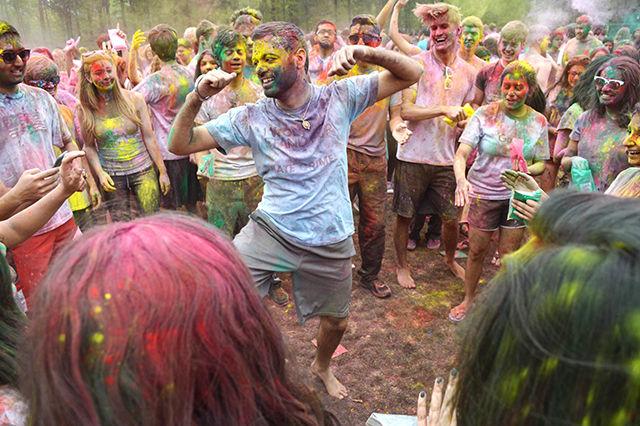
Kaydee Gawlik
Holi is an ancient Hindu festival, known as the festival of colors or the festival of sharing love, announcing the passing of winter and arrival of spring. It is typically celebrated with dancing, singing, and throwing colored powders. Despite officially being on Wednesday (3/23), students came together to celebrate on Lee Feild on Saturday, March 19, 2016.
Clouds of color filled the air and out emerged students masked in powder. On Saturday, over 500 students celebrated Holi, a festival of colors, at Lee Field.
“It’s a festival of colors, so you just forget everything and enjoy,” said Zeal Ganatra, a graduate student studying computer science. Ganatra is a member of Maitri, NC State’s Indian Graduate Student Association, and helped run the event. “We have no structure, we’re just playing the music and you can do whatever you want.”
Maitri, Ektaa, Union Activities Board, Delta Sigma Iota Inc. and Kappa Phi Lambda Inc. hosted the celebration.
“It’s a completely spontaneous event,” said Sathvik Divi, a graduate student studying mechanical engineering and member of Maitri. “You have color on you, so which is the face that you want to throw it in?”
Holi is a traditional Indian festival that is rooted in Hinduism.
The story of Holi tells of an evil king who hated the Indian god Lord Vishnu. When the king’s son began praying to Lord Vishnu, the king tried to kill him. However, the son kept praying to Lord Vishnu and was able to stay alive.
“The meaning has kept on changing … for many years,” said Shivam Gulati, a graduate student studying computer science and member of Maitri.
In intervals of 20 minutes, organizers passed out free packets of color to attendees. All of the colors were imported from India.
Divi described the event as a way to have fun and celebrate successes.
“Given that it’s at NC State and it’s just after spring break and before spring break a lot of people have midterms, it’s a way for people to celebrate their success,” Divi said. “Or for the others, who are not so successful, it’s a way to cope with the post-midterm trauma.”
In addition, Divi sees Holi as a way to make new friends.
“This is an event where you also get to meet strangers, because after a certain point everybody’s face has colors on them,” Divi said.
Ganatra replied, “You don’t realize who is who.”
Shikhar Arora, a sophomore studying mechanical engineering who is from India, appreciated the event’s authenticity.
“It was a pleasant experience for me where I got to see so many other people, not only of my religion or my community… so it was a great experience overall I think,” Arora said. “They were successful in portraying it how we used to do it when I was young.”
However, Arora felt the event came up short in teaching attendees why Holi is celebrated.
Ruhani Agrawal, a sophomore studying genetics, described the significance of Holi.
“Culturally, [Holi is] kind of like the welcoming of spring,” Agrawal said. “Religiously … it’s pretty much good over evil, and good wins every time.”
Bryan Murphy contributed to the reporting of this story.